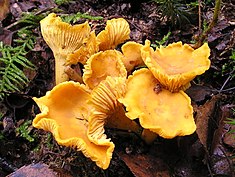Cantharellus cibarius
| Cantharellus cibarius | |
|---|---|
 |
|
| Scientific classification | |
| Kingdom: | Fungi |
| Phylum: | Basidiomycota |
| Class: | Agaricomycetes |
| Order: | Cantharellales |
| Family: | Cantharellaceae |
| Genus: | Cantharellus |
| Species: | C. cibarius |
| Binomial name | |
|
Cantharellus cibarius Fr. (1821) |
|
| Synonyms | |
|
Species synonymy
|
|
| Cantharellus cibarius | |
|---|---|
| Mycological characteristics | |
| ridges on hymenium | |
| cap is infundibuliform | |
| hymenium is decurrent | |
| stipe is bare | |
|
|
spore print is yellow to cream |
| ecology is mycorrhizal | |
| edibility: choice | |
| Nutritional value per 100 g (3.5 oz) | |
|---|---|
| Energy | 160 kJ (38 kcal) |
|
6.86 g
|
|
| Sugars | 1.16 g |
| Dietary fiber | 3.8 g |
|
0.53 g
|
|
|
1.49 g
|
|
| Vitamins | |
| Riboflavin (B2) |
(18%)
0.215 mg |
| Niacin (B3) |
(27%)
4.085 mg |
| Pantothenic acid (B5) |
(22%)
1.075 mg |
| Vitamin B6 |
(3%)
0.044 mg |
| Vitamin D |
(35%)
5.3 μg |
| Minerals | |
| Calcium |
(2%)
15 mg |
| Iron |
(27%)
3.47 mg |
| Magnesium |
(4%)
13 mg |
| Manganese |
(14%)
0.286 mg |
| Phosphorus |
(8%)
57 mg |
| Potassium |
(11%)
506 mg |
| Sodium |
(1%)
9 mg |
| Zinc |
(7%)
0.71 mg |
|
|
|
|
|
| Percentages are roughly approximated using US recommendations for adults. Source: USDA Nutrient Database |
|
spore print is yellow
Cantharellus cibarius, commonly known as the chanterelle, or girolle, is a fungus. It is probably the best known species of the genus Cantharellus, if not the entire family of Cantharellaceae. It is orange or yellow, meaty and funnel-shaped. On the lower surface, underneath the smooth cap, it has gill-like ridges that run almost all the way down its stipe, which tapers down seamlessly from the cap. It emits a fruity aroma, reminiscent of apricots and a mildly peppery taste (hence its German name, ) and is considered an excellent edible mushroom.
Chanterelles are common in northern parts of Europe, North America, Central America, including Mexico, in Asia, including Turkey and the Himalayas (including Kashmir, Nepal, and Bhutan), and in Africa including Zambia, Congo and Uganda. Chanterelles tend to grow in clusters in mossy coniferous forests, but are also often found in mountainous birch forests and among grasses and low-growing herbs. In central Europe, including Ukraine, the golden chanterelle is often found in beech forests among similar species and forms. In the UK, they may be found from July through December.
At one time, all yellow or golden chanterelles in western North America had been classified as C. cibarius. Using DNA analysis, they have since been shown to be a group of related species. In 1997, the Pacific golden chanterelle (C. formosus) and C. cibarius var. roseocanus were identified, followed by C. cascadensis in 2003 and C. californicus in 2008.C. cibarius var. roseocanus occurs in the Pacific Northwest in Sitka spruce forests, as well as Eastern Canada in association with Pinus banksiana.
Chanterelles are relatively high in vitamin C (0.4 mg/g fresh weight), very high in potassium (about 0.5%, fresh weight), and are among the richest sources of vitamin D known, with ergocalciferol (vitamin D2) as high as 212 IU/100 grams fresh weight.Scientific research has suggested that the golden chanterelle may have potent insecticidal properties that are harmless to humans and yet protect the mushroom body against insects and other potentially harmful organisms.
...
Wikipedia
